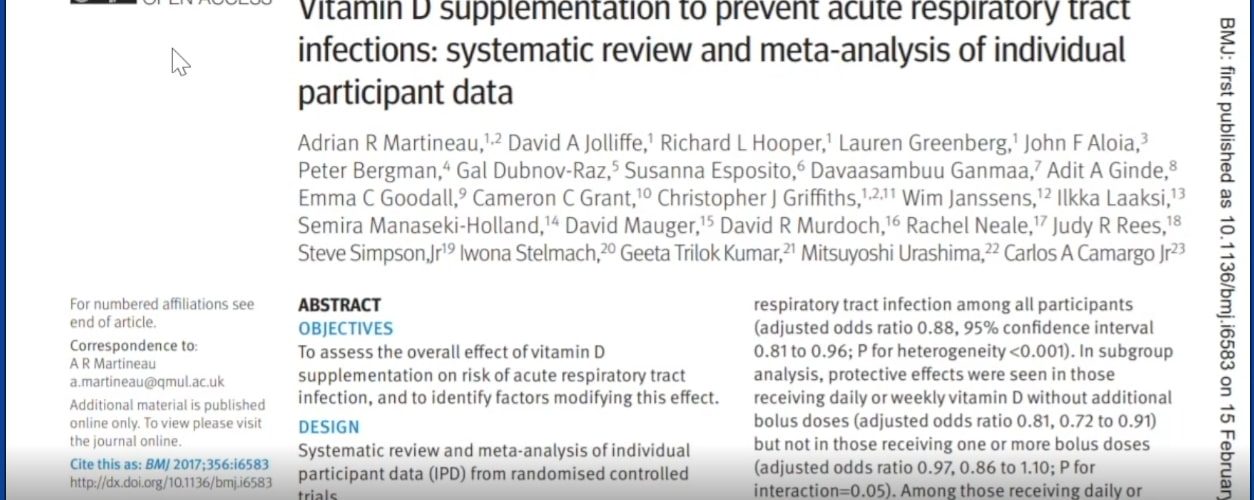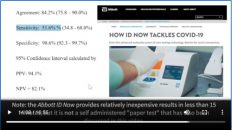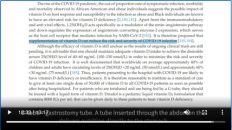维生素D可能有助于预防新冠肺炎
More Global COVID-19 Outbreaks, Vitamin D May Aid Prevention (Lecture 30)
Welcome to another MedCram covid-19 update. We will do some updates and also talk about preparation from a prevention standpoint. Here, we have our Johns Hopkins dashboard at 9,400 total confirmed cases; total deaths 3,200; total recovered 51,000. South Korea has the most confirmed outside of China, and we’re talking about aggressive testing in South Korea and Iran quickly shot up; we can see here. That’s a pretty large red dot.
欢迎来到MedCram covid-19的另一个更新。我们将进行一些更新,并从预防的角度讨论准备工作。在这里,我们有约翰霍普金斯大学(Johns Hopkins)仪表板,共有9,400例确诊病例;死亡总数3200;总共追回了51,000。在中国以外,韩国得到了最充分的证实,我们正在谈论在韩国进行的激进试验,而伊朗迅速飙升。我们可以在这里看到。那是一个很大的红点。
If we go to the Worldometer website. Active cases are actually on the decline probably because we are leaving an epidemic in China, but there are small epidemics relatively outside of China that are rapidly growing, and that’s why this is not continuing to go down. If we look at total cases, we can see that the inflection point has started to turn upwards.
如果我们转到Worldometer网站。实际上,活跃病例在减少,可能是因为我们正在中国留下流行病,但是相对而言,在中国境外有小规模流行病正在迅速增长,这就是为什么这种情况不会持续下去的原因。如果我们查看全部案例,则可以看到拐点已经开始向上旋转。
Let’s look at the latest updates. A number of countries are reporting single digits cases, and in some cases, some deaths. Interestingly here, there are 586 new cases in Iran, but they’re also starting to show recoveries as well. We knew there would be recoveries, but we’re just not seeing a lot at this point.
让我们看看最新的更新。许多国家/地区正在报告个位数的案件,在某些情况下还报告死亡人数。有趣的是,伊朗有586例新病例,但它们也开始显示出复苏的趋势。我们知道会有恢复的迹象,但是目前我们还没有看到太多。
We see that there are 10 new cases in Belgium; 9 of which came from northern Italy, and that seems to be a hot spot of spread throughout Europe. Remember that in Europe, there are free borders because of the European Union, so it’s not as if this is unregulated, constrained travel, at least as of a couple of weeks ago.
我们看到比利时有10个新病例。其中有9个来自意大利北部,这似乎是遍布欧洲的热点。请记住,在欧洲,由于欧盟存在自由边界,所以至少在几周前,这似乎并不是不受管制的旅行。
Four new cases in the United States; all of them being in California, which is a hot spot. There’s one in Los Angeles County; two who had recently traveled to countries that have had covid-19, and there’s one new case in Contra Costa County in Northern, California.
美国有四起新案件;他们都在加利福尼亚,这是一个热点。洛杉矶县有一个。两名最近去过covid-19的国家/地区,并且在加利福尼亚北部的Contra Costa县有一个新病例。
That’s like in case of coronavirus in Los Angeles; was reported by Fox 11 News that the patient is being taken care of at home in self-isolation and being treated on an outpatient basis.
这就像洛杉矶的冠状病毒一样。据福克斯11新闻报道,该患者正在自我隔离中在家中接受照顾,并在门诊接受治疗。
The purpose of MedCram, what we’re doing here, is to talk about the data, the raw numbers, to talk about the medical aspects of this virus, and what we know is going to work. But of course there are things that are out there that are emerging that seem to have evidence but don’t quite fit with coronavirus at this point because we don’t have the data. At this point, let’s face it. We have no randomized controlled trials for coronavirus covid-19. They just haven’t been performed. So we’re forced to look at things that may work.
MedCram的目的是要讨论数据,原始数据,还要讨论该病毒的医学方面,以及我们所知道的将起作用的内容。但是,当然有一些新出现的东西似乎有证据,但由于我们没有数据,目前还不适合冠状病毒。在这一点上,让我们面对现实。我们还没有针对冠状病毒covid-19的随机对照试验。他们只是没有被执行。因此,我们不得不考虑可能有效的方法。
Vitamin D is one of those things we don’t have any randomized control trials that show that supplement with vitamin D works in covid-19, but we do have data about vitamin D specifically, and so I think it’s interesting to go over. I’ve gotten a lot of comments from people about vitamin D and the potential use for the coronavirus.
维生素D是其中之一,我们没有任何随机对照试验表明维生素D的补充剂可在covid-19中起作用,但是我们确实有关于维生素D的数据,因此,我认为继续学习很有趣。关于维生素D和冠状病毒的潜在用途,我收到了很多人的评论。
And even though this paper here is for the influenza virus, vitamin D is not actually having an effect on the virus itself as far as we know. It’s affecting the hosts, us, our bodies, our immune system, and how they deal with the virus. So potentially (vitamin D) might be something that is applicable to other viruses, and, in this case, the coronavirus.
即使本文是针对流感病毒的,但据我们所知,维生素D实际上并未对病毒本身产生影响。它影响着宿主,我们,我们的身体,我们的免疫系统以及它们如何处理病毒。因此,潜在的(维生素D)可能适用于其他病毒,在这种情况下还适用于冠状病毒。
And if you’ve thought about this, you’ll notice that there’s a lot of talk about what will happen in the summertime to the virus, and a lot of the talk has been about heat and humidity versus dryness, and I’m wondering if there’s another angle on this because vitamin D could be acknowledged as ” a seasonal stimulus” as defined by our Edgar. Hope Simpson. It will be crucial to prove it from a potentially easy and cheap prophylaxis or therapy support perspective. As far as influenza infections are concerned.
而且,如果您考虑过这一点,您会发现有很多关于夏季病毒会发生什么的话题,而且很多话题都是关于高温高湿与干燥的关系,我想知道是否还有其他观点,因为维生素D可以被我们的Edgar定义为“季节性刺激”。希望辛普森。从潜在的简便,廉价的预防或治疗支持角度证明这一点至关重要。就流感感染而言。
Now this paper talks about how, first of all, vitamin D is absorbed into the body, and how it is metabolized. The fact that it is a vitamin, you have to understand that we cannot generate or make vitamin D in our own body. But in fact, we need ultraviolet radiation from the sun to convert the inactive form to the active form.
现在,本文首先讨论维生素D如何吸收到体内以及如何代谢。它是维生素的事实,您必须了解我们无法在自己的体内生成或制造维生素D。但是实际上,我们需要来自太阳的紫外线才能将非活性形式转化为活性形式。
I’ve always had a special place in my heart for vitamin D because that’s what I did in terms of my undergraduate research working in organic chemistry. And so you’ll know that vitamin D, for those of you studied, the structure is a lipid-soluble vitamin, and so it’s possible to overdose on vitamin D. So you have to be very careful with it because it is fat-soluble.
对于维生素D,我一直在心中占有特殊的位置,因为这是我在有机化学方面的本科生研究中所做的。因此,您将知道维生素D,对于您所研究的那些人来说,该结构是脂溶性维生素,因此可能会过量服用维生素D。因此,由于它是脂溶性的,因此必须非常小心。
Now there’s a lot of talk about vitamin D in the immune system, and how it bolsters it, but something that’s also very interesting about vitamin D is it’s possible role in infections. And also it has a suppressive anti-inflammatory process. So, in other words, vitamin D can turn things on, and it can also turn things off. It’s not uni-modal, and that is something that could be very helpful, especially in the immune response that we see in covid-19.
现在有很多关于免疫系统中维生素D以及如何增强维生素D的讨论,但是维生素D也很有趣的一点是它可能在感染中起作用。并且它具有抑制性的消炎过程。因此,换句话说,维生素D可以打开事物,也可以关闭事物。它不是单峰的,这可能会很有帮助,特别是在我们在covid-19中看到的免疫反应中。
Remember that it’s the immune system that is going to suppress the virus, which is good, but it’s also the immune system that could cause this storm of cytokines that puts your lungs into ARDS and could potentially kill.
请记住,抑制病毒的免疫系统是有益的,但是免疫系统也可能引起这种细胞因子风暴,使您的肺部进入ARDS并可能导致死亡。
So what we want is a smart immune system, an immune system that takes care of the virus but doesn’t put us into an inflammatory condition that could put us on a ventilator. So is vitamin D the answer? I have no financial relationships with any pharmaceutical companies or companies that make nutritional supplements in any way.
因此,我们想要的是一个智能的免疫系统,即一种能够处理病毒但不会使我们处于可能使我们无法呼吸的炎性疾病的免疫系统。那么维生素D是答案吗?我与任何制药公司或以任何方式制作营养补品的公司都没有财务关系。
This study that was talked about here in the Harvard Gazette may be what we’re looking for here. It says a new global collaborative study has confirmed that vitamin D supplementation can help protect against acute respiratory infections. The study, the participant data meta-analysis. So a meta-analysis is simply a study that looks at a whole bunch of other studies, breaks down the components, and makes a super study out of it.
在哈佛宪报上讨论的这项研究可能就是我们在这里寻找的。它说,一项新的全球合作研究已经证实,补充维生素D可以帮助预防急性呼吸道感染。本研究中,参加者数据进行荟萃分析。因此,荟萃分析只是一项研究,它研究了许多其他研究,分解了各个组成部分,并从中进行了超级研究。
So they took actually 25 randomized controlled trials within an N number of 11,000 participants. That’s a pretty sizable number. This was published in the British medical journal. I will give you a link to that journal. We will actually look through that.
因此,他们实际上在N个11,000名参与者中进行了25项随机对照试验。这是一个相当大的数字。这发表在英国医学杂志上。我会给您该日记的链接。我们将实际浏览一下。
Most people understand that vitamin D is critical for bone and muscle health, says Carlos Camargo of the Department of Emergency Medicine at Massachusetts General Hospital. Our analysis has also found that it helps the body fight acute respiratory infection, which is responsible for millions of deaths globally each year. Remember this article was published before coronavirus.
马萨诸塞州总医院急诊科的卡洛斯·卡玛戈(Carlos Camargo)说,大多数人都知道维生素D对骨骼和肌肉健康至关重要。我们的分析还发现,它可以帮助人体抵抗急性呼吸道感染,每年全球造成数百万人死亡。请记住,本文是在冠状病毒之前发表的。
Several observational studies with track participants over time without assessing a specific treatment have associated low vitamin D levels with greater susceptibility to acute respiratory infections. I don’t have to tell you that living in high latitudes, especially in the wintertime, exposes you to the least amount of sunlight. If you have the least amount of sunlight, you would conclude appropriately that your vitamin D levels are generally going to be on the lower side.
随着时间的推移,一些追踪参与者的观察性研究没有评估具体的治疗方法,认为维生素D水平低与急性呼吸道感染的敏感性更高。我不必告诉你,生活在高纬度地区,尤其是在冬天,会使您暴露在最少的阳光下。如果您的阳光量最少,则可以适当地得出结论,您的维生素D水平通常会偏低。
Well, it’s possible that the seasonal variation in the virus may still have something to do with the survival of the virus outside the body, but it may have more than we think to do with the survival of the virus inside the body. It is a postulate, but it’s interesting. The meta-analysis of these trials which aggregate data from several studies that may have different designs or participant qualifications also had conflicting results.
好吧,病毒的季节性变化可能仍然与病毒在体外的存活有关,但它可能比我们认为的更多与病毒在体内的存活有关。这是一种假设,但很有趣。这些试验的荟萃分析汇总了几项研究的数据,这些研究可能具有不同的设计或参加者资格,其结果也相互矛盾。
And this really has been the issue for some period of time. Some studies show that there is a connection that makes vitamin D look good in terms of preventing infections; others, not so good. So to resolve these discrepancies, this research team out of Queen Mary University of London conducted an individual participant data meta-analysis.
这确实是一段时间以来的问题了。一些研究表明,某种联系可以使维生素D在预防感染方面看起来不错。其他人,不是很好。因此,为了解决这些差异,伦敦玛丽皇后大学的这个研究小组对参与者的数据进行了荟萃分析。
What does that mean? They grouped all of these studies together, and then they stripped it down to each particular individual, and that is very powerful, producing what could be considered a higher-resolution analysis of the data from all the studies.
这意味着什么?他们将所有这些研究分组在一起,然后将其分解为每个特定的个体,这非常强大,从而可以对所有研究的数据进行高分辨率分析。
The investigators found that daily or weekly supplementation had the greatest benefit for individuals. Number one. There was a benefit. And number two: it was the turtle, not the hair. What I mean by that is it was the daily supplementation, not the huge doses of vitamin D, if you got sick.
研究人员发现,每日或每周补充对个体最大的好处。第一。有好处。第二点:是乌龟,而不是头发。我的意思是,如果您生病了,那就是每天补充,而不是大剂量的维生素D。
This makes sense to people who have the lowest levels are going to have the best effect from supplementation, and it cut their risk of respiratory infection in half. That is a significant number and could reduce the R-naught or the replication number in viruses, and it may be the reason why we see these viruses disappear in the summer. I say MAY; don’t have proof of that yet, but it’s interesting.
对于水平最低的人来说,补充营养会产生最佳效果,这将他们的呼吸道感染风险降低了一半。这是一个很大的数字,并且可以减少病毒中的R零或复制数,这可能是我们看到这些病毒在夏天消失的原因。我说五月;尚无证据,但这很有趣。
All participants experienced some beneficial effects from REGULAR vitamin D supplementation. Administering high doses of vitamin D did not produce significant benefits. This study was not funded by some nutritional company, but was funded in fact by the British National Institute of Health Research.
所有参与者都从常规维生素D补充剂中受益匪浅。服用高剂量的维生素D并没有产生明显的益处。这项研究不是由某些营养公司资助的,而实际上是由英国国家健康研究所资助的。
So let’s actually go to that study. It’s open access, and I will put the link in the description below. This is from the British Medical Journal; that’s a very prestigious publication. In the conclusion, vitamin D supplementation was safe, and it protected against acute respiratory tract infection overal. Patients who were very vitamin D deficient, and those not receiving bolus dose (a single dose of big quantity), have experienced the most benefit.
因此,让我们实际去研究一下。它是开放式访问,我将在下面的描述中添加链接。这是来自《英国医学杂志》;那是非常有声望的出版物。总之,补充维生素D是安全的,并且可以防止急性呼吸道感染。维生素D极度缺乏的患者以及未接受推注剂量(大量的单剂量)的患者,其获益最大。
So, if you go down to the raw data, they had to come up with cut-off points. And for those of you who don’t know how to read studies, let me show you here a little bit. What they’re looking at is how many respiratory tract infections they receive. So “one step individual participant data meta-analysis, proportion of participants experiencing at least one acute respiratory tract infection.”
因此,如果您查看原始数据,则必须提出临界点。对于那些不知道如何阅读研究的人,让我在这里给您一点点展示。他们正在看的是他们收到了多少呼吸道感染。因此,“一步一步进行个体参与者数据荟萃分析,参与者中至少经历一种急性呼吸道感染的比例”。
First thing to do is to look at the very top one, and that’s overall. How many trials? 25. Proportion with greater than 1 acute respiratory tract infection, and proportion with greater than 1 acute respiratory tract infection in the intervention group, and you can see that there was a difference. And what was the difference? The adjusted odds ratios where you want to look.
首先要做的是查看最顶层的内容,这就是整体。多少试验? 25.在干预组中,急性呼吸道感染大于1的比例,以及急性呼吸道感染大于1的比例,您会发现两者之间存在差异。有什么区别?想要查看的调整后的优势比。
There’s another way of looking at two, looking at P values, to see if there’s a difference between these two groups. Those in the control group, those in the intervention group, and any p-value of less than .05 is considered to be statistically significant. So you can see here that a bolus dose of greater than 30,000 international units given had a p-value of .67, that’s greater than .05. Therefore, it is not statistically significant. In other words, a bolus dose is not going to be helpful. If the toast wasn’t given, you can see that was very statistically significant.
还有两种查看P值的方法,以查看这两组之间是否存在差异。对照组,干预组中的那些以及任何小于0.05的p值都被认为具有统计学意义。因此,您可以在此处看到,给定的大于30,000国际单位的推注剂量的p值为0.67,大于0.05。因此,它在统计上并不重要。换句话说,推注剂量将无济于事。如果不吐司,您会发现这在统计上非常重要。
So the question is how much should I take on a daily dose? Well, here it is: daily dose equivalent. If it was less than 20 micrograms, highly statistically significant; if it was 20-50, still statistically significant. However, if you took more than 50 micrograms, there was no difference between that group, indicating that a modest dose of vitamin D every single day would be the best.
所以问题是我应该每天服用多少剂量?好吧,这是:日剂量当量。如果小于20微克,则具有高度统计意义;如果是20-50,则仍具有统计意义。但是,如果您服用超过50毫克,则两组之间没有差异,这表明每天适量服用维生素D是最好的。
Here’s more research in the study, showing all of the different individual studies and the proportion with greater than 1 acute respiratory tract infection. You can see here where they lined up relative to number 1. Number 1 being no difference. If it was less than number 1 with a 95% confidence interval less than 1, then you could say that that was statistically significant. And it was weighted based on the number of patients in that study. Finally, we come to the overall, which is here at the bottom, P-value of .001. You can see that it lands less than 1.
这是该研究中的更多研究,显示了所有不同的个体研究以及大于1种急性呼吸道感染的比例。您可以在此处看到它们相对于数字1排列的位置。数字1没有区别。如果它小于1,且95%置信区间小于1,则可以说这在统计上是有意义的。并根据该研究中的患者人数进行加权。最后,我们得出总体的P值(.001),位于底部。您会看到它的降落小于1。
If you scroll down to the discussion, it says vitamin D supplementation reduces the risk of experiencing at least one acute respiratory tract infection, and it talks about the grade of the data, which was very good. The question though is why would a bolus dose of vitamin D be ineffective, and they talk about how the wide fluctuations of circulating 25 hydroxy vitamin D concentrations, which is the starting material for the active form in the body, could deregulate activity of enzymes responsible for the synthesis and degradation of the active vitamin D metabolites, which is 125 dihydroxy vitamin D. So my recommendation based on this data would be to take a small supplement of vitamin D every day. And again, we’ll put the links to these articles in the description below.
如果您滚动到讨论内容,它说补充维生素D可以降低至少发生一种急性呼吸道感染的风险,并且它谈论的数据等级也非常好。问题是为什么大剂量的维生素D无效,他们谈论循环中的25个羟基维生素D浓度(人体中活性形式的起始物质)的宽幅波动如何使负责酶的活性失控。用于合成和降解活性维生素D代谢物,即125二羟基维生素D。因此,基于此数据,我的建议是每天服用少量维生素D。同样,我们将在以下描述中提供这些文章的链接。





Add comment